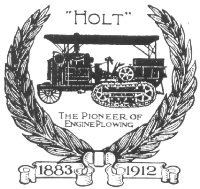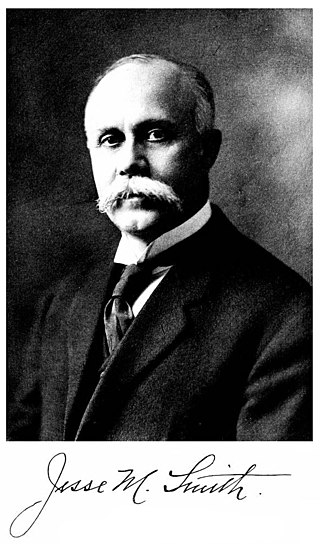
A locomotive or engine is a rail transport vehicle that provides the motive power for a train. If a locomotive is capable of carrying a payload, it is usually rather referred to as a multiple unit, motor coach, railcar or power car; the use of these self-propelled vehicles is increasingly common for passenger trains, but rare for freight trains.

Continuous track or tracked treads are a system of vehicle propulsion used in tracked vehicles, running on a continuous band of treads or track plates driven by two or more wheels. The large surface area of the tracks distributes the weight of the vehicle better than steel or rubber tyres on an equivalent vehicle, enabling continuous tracked vehicles to traverse soft ground with less likelihood of becoming stuck due to sinking.

A tank locomotive or tank engine is a steam locomotive which carries its water in one or more on-board water tanks, instead of a more traditional tender. Most tank engines also have bunkers to hold fuel; in a tender-tank locomotive a tender holds some or all of the fuel, and may hold some water also.

The Great Black Swamp was a glacially fed wetland in northwest Ohio and northeast Indiana, United States, that existed from the end of the Wisconsin glaciation until the late 19th century. Comprising extensive swamps and marshes, with some higher, drier ground interspersed, it occupied what was formerly the southwestern part of proglacial Lake Maumee, a Holocene precursor to Lake Erie. The area was about 25 miles (40 km) wide and 100 miles (160 km) long, covering an estimated 1,500 square miles (4,000 km2). Gradually drained and settled in the second half of the 19th century, it is now highly productive farmland. However, this development has been detrimental to the ecosystem as a result of agricultural runoff. This runoff, in turn, has contributed to frequent toxic algal blooms in Lake Erie.

Benjamin Leroy Holt was an American businessman and inventor who patented and manufactured the first practical crawler-type tread tractor. The continuous-type track is used for heavy agricultural and engineering vehicles to spread the weight over a large area to prevent the vehicle from sinking into soft ground. He founded with his brothers the Holt Manufacturing Company.

Aveling and Porter was a British agricultural engine and steamroller manufacturer. Thomas Aveling and Richard Thomas Porter entered into partnership in 1862, and developed a steam engine three years later in 1865. By the early 1900s, the company had become the largest manufacturer of steamrollers in the world. The company used a rampant horse as its logo derived from the White Horse of Kent.

A steam turbine locomotive was a steam locomotive which transmitted steam power to the wheels via a steam turbine. Numerous attempts at this type of locomotive were made, mostly without success. In the 1930s this type of locomotive was seen as a way both to revitalize steam power and challenge the diesel locomotives then being introduced.

Richard Hornsby & Sons was an engine and machinery manufacturer in Grantham, Lincolnshire, England from 1828 until 1918. The company was a pioneer in the manufacture of the oil engine developed by Herbert Akroyd Stuart, which was marketed under the Hornsby-Akroyd name. The company developed an early track system for vehicles, selling the patent to Holt & Co. in America. In 1918, Richard Hornsby & Sons became a subsidiary of the neighbouring engineering firm Rustons of Lincoln, to create Ruston & Hornsby.
Tile drainage is a form of agricultural drainage system that removes excess sub-surface water from fields to allow sufficient air space within the soil, proper cultivation, and access by heavy machinery to tend and harvest crops. While surface water can be drained by pumping, open ditches, or both, tile drainage is often the most effective means of draining subsurface water.

A jackshaft is an intermediate shaft used to transfer power from a powered shaft such as the output shaft of an engine or motor to driven shafts such as the drive axles of a locomotive. As applied to railroad locomotives in the 19th and 20th centuries, jackshafts were typically in line with the drive axles of locomotives and connected to them by side rods. In general, each drive axle on a locomotive is free to move about one inch (2.5 cm) vertically relative to the frame, with the locomotive weight carried on springs. This means that if the engine, motor or transmission is rigidly attached to the locomotive frame, it cannot be rigidly connected to the axle. This problem can be solved by mounting the jackshaft on unsprung bearings and using side-rods or chain drives.

David Roberts was the Chief Engineer and managing director of Richard Hornsby & Sons in the early 1900s. His invention, the caterpillar track, was demonstrated to the army in 1907.

Michael Joseph Owens was an inventor of machines to automate the production of glass bottles.

Under the Whyte notation for the classification of steam locomotives, 0-6-0+0-6-0 represents the wheel arrangement of an articulated locomotive with two separate swivelling engine units, each unit with no leading wheels, six powered and coupled driving wheels on three axles and no trailing wheels. The arrangement is effectively two 0-6-0 locomotives operating back-to-back and was used on Garratt, Double Fairlie, Meyer and Kitson-Meyer articulated locomotives. A similar arrangement exists for Mallet steam locomotives on which only the front engine unit swivels, but these are referred to as 0-6-6-0.

The Holt Manufacturing Company began with the 1883 founding of Stockton Wheel Service in Stockton, California, United States. Benjamin Holt, later credited with patenting the first workable crawler ("caterpillar") tractor design, incorporated the Holt Manufacturing Company in 1892. Holt Manufacturing Company was the first company to successfully manufacture a continuous track tractor By the early 20th century, Holt Manufacturing Company was the leading manufacturer of combine harvesters in the US, and the leading California-based manufacturer of steam traction engines.

Bramah Joseph Diplock was an English inventor who invented the pedrail wheel in 1899 and the pedrail chaintrack, a type of caterpillar track, in 1907.

The Lombard Steam Log Hauler, patented 21 May 1901, was the first successful commercial application of a continuous track for vehicle propulsion. The concept was later used for military tanks during World War I and for agricultural tractors and construction equipment following the war.
Janney couplers are a semi-automatic form of railway coupling that allow rail cars and locomotives to be securely linked together without rail workers having to get between the vehicles. They are also known as American, AAR, APT, ARA, MCB, knuckle, Buckeye, tightlock or Centre Buffer Couplers.

Richard Henry Rice was an American mechanical engineer and inventor who is known for many patents related to improvements to the Corliss steam engine, and his partnership in founding the Rice & Sargent Engine Company of Providence, Rhode Island.

Joseph Flavius Holloway was an American mechanical engineer, President of the Cuyahoga Steam Furnace Co., and president of the American Society of Mechanical Engineers in 1885–86.

Jesse Merrick Smith was a prominent American mechanical engineer, consulting engineer, patent expert, and president of the American Society of Mechanical Engineers in the year 1909-10.


















